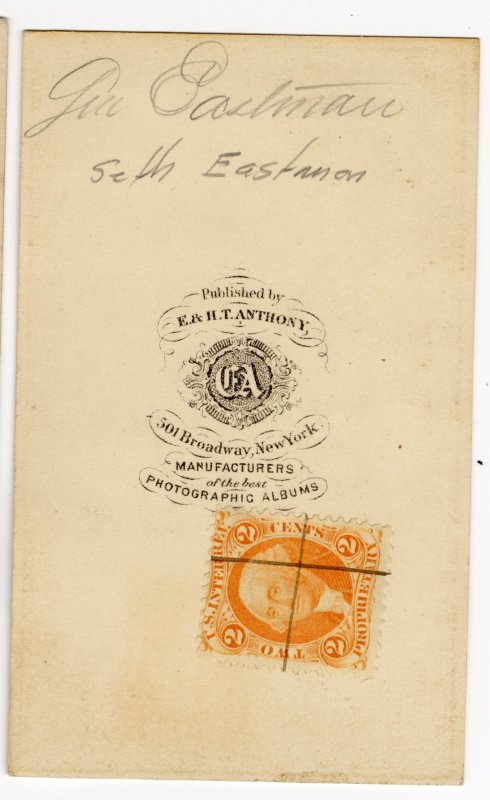Seth Eastman - Elmira Prison Camp
Item CDV-10565
Seth Eastman
Price: $325.00
Description
Seth EastmanSoldier & Noted Artist
United States Army
USMA - Class of 1829
Lieutenant, Captain Major & Lieutenant Colonel
Brevet Promotions:Colonel & Brigadier General
Backmark: Anthony
Seth Eastman was one of the foremost painters of North America and the Mississippi River. A graduate of West Point in 1829, he was posted to Ft. Crawford, Wisconsin and Ft. Snelling, Minnesota from 1829-1831, and he began sketching Indian life as the basis for an Indian portrait gallery. Because of his training as a topographic artist, Eastman painted what he saw rather than attempting to compose his picture. During the time he was stationed at Fort Snelling, he was married to Stands-Like-a-Spirit, the daughter of Cloud Man, the leader of the Dakota settlement on the shore of Lake Calhoun in what is now Minneapolis.
Eastman returned to West Point in 1833 to teach drawing classes. He then served in the Seminole War (1840) and eventually transferred back to Ft. Snelling where he continued to sketch, painting over 400 river and Indian scenes in 7 years.
Eastman’s pencil sketches and watercolors introduced Native American tribes along the rivers in the west to an eager audience. Several of the works depict the Falls of St. Anthony and Fort Snelling. Prominent artists, including Henry Lewis, creator of the Mississippi River Panorama, used Eastman’s drawings as the basis for their own works. In 1851, Henry Schoolcraft selected Eastman as the artist for his six-volume Indian Tribes of the U.S.
Having retired as a Brigadier General for disability during the American Civil War, Eastman was reactivated when commissioned to make paintings for Congress. Between 1867 and 1869, he painted a series of nine scenes of American Indian life for the House Committee on Indian Affairs. In 1870 he was commissioned by Congress to create a series of 17 paintings of important U.S. fortifications, to be hung in the meeting rooms of the House Committee on Military Affairs which he completed in 1875.
Through Seth Eastman’s explicitly realistic depictions, in both pen and oil, he left a lasting legacy of the frontier, American Indian life, and life on the river.
Source: National Mississippi River Museum and Aquarium
ELMIRA PRISON
On April 15, 1861, President Lincoln called for 75,000 volunteer troops to help suppress the rebellion. Elmira was one of three locations chosen as training centers in New York due to its location and railway hub. Troops were first housed in rented buildings, but these quickly became overwhelmed when an additional 500,000 troops were called for later that year. Four military installations were constructed throughout the city; Arnott Barracks, Camp Rathbun, Camp Robinson, and Post Barracks.
The number of troops stationed in the city fluctuated for the first few months, and by June 1862, only fifty men occupied Camp Rathbun. This led to the closing of both Camp Robinson and Post Barracks, and they would never be used again. A month later, in July, conscription was enacted by the US Congress, and by 1863, Elmira was once again filled with troops. During this time, the city was named draft rendezvous headquarters for the western part of New York. At the beginning of 1864, the headquarters was placed under command of Lieutenant Colonel Seth Eastman. More facilities were built at the remaining two camps, and upon completion, allowed Camp Rathbun to hold up to 5,000 troops in the barracks, with an additional 1,000 troops in tents.
In the first years of the war, there had been a prisoner exchange system, and most prisons lay empty. Confederate mistreatment and enslavement of Black Union soldiers in 1863 disrupted this system; by April 1864 it had been completely suspended, and prisons quickly became overcrowded. Space had recently opened up in Elmira after the departure of six companies of the 179th New York Volunteer Infantry Regiment. Commissary General of Prisoners William Hoffman was informed of this, and on May 19 he sent word to Eastman to "set apart the barracks on the Chemung River at Elmira as a depot for prisoners of war." He was also informed that the prison might be needed within ten days and that it might have to accommodate 8,000 or up to 10,000 prisoners.
According to Eastman's calculations, the camp could hold only half that properly. In addition, Eastman reported that the kitchens could feed only 5,000 a day and the mess room could seat only 1,500 men at once. To top all of this off, there were no hospital facilities in the camp; the soldiers instead relied on facilities in the town. Still, Eastman was told to be prepared to receive prisoners, and from the beginning it would seem that the camp was destined to be overcrowded. This led to many charges that the prison camp was designed from the beginning to be not a prison, but a death camp.
Source: Wikipedia, Elmira Prison Camp


